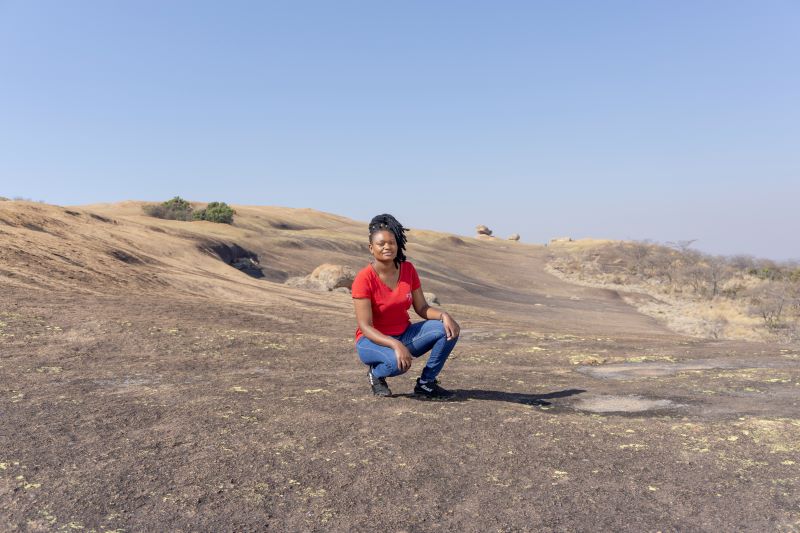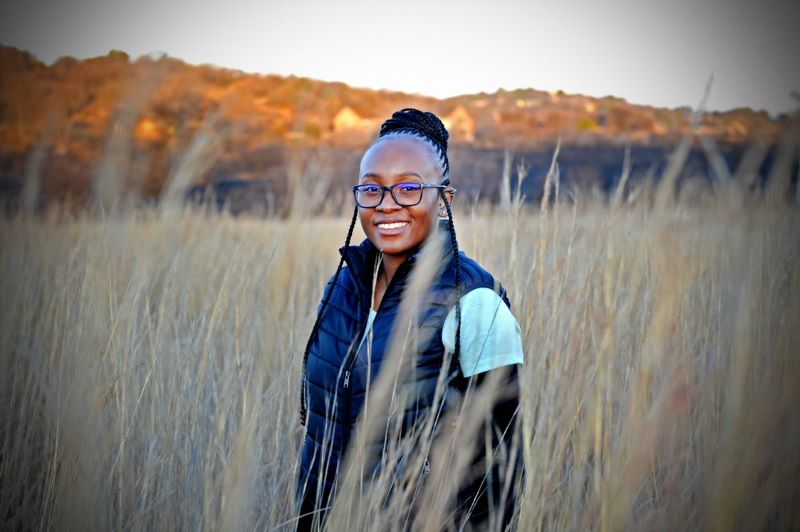Palaeoscience fellows score for science and diversity
20 August 2020 | Story Helen Swingler. Voice Lerato Molale. Read time 8 min.
University of Cape Town (UCT) PhD students Precious Chiwara-Maenzanise and Rivoningo Khosa are undertaking groundbreaking work in the palaeosciences. As the Human Evolution Research Institute’s (HERI) inaugural 2020 Advancing Womxn fellows, they plan to make a mark for science and diversity in a field that is still too homogeneous.
The fellowships are part of an initiative launched in August two years ago by Vice-Chancellor Professor Mamokgethi Phakeng. One version of this is the For Womxn By Womxn research grants, which are intended to spur more opportunities for women researchers. As such, the awards underpin training programmes for postgraduates and postdoctoral fellows, particularly those under-represented in academia – black South African women and transgender researchers.
Supporting young, black women is the hallmark of HERI’s efforts to grow diversity in the palaeosciences. In a recent HERI blog, director, Dr Robyn Pickering, remarked on this: “We set out with the aim of fostering the next generation of black womxn in human evolution and I was blown away by these candidates,” she wrote. “My hope for Rivoningo and Precious is that they find an academic home at HERI, a place where they can thrive as researchers and do excellent science.”
Precious Chiwara-Maenzanise – Early modern humans of the Kalahari
It’s been a heady but strange time for both new fellows amid the start-stop dislocations of COVID-19 lockdown and the curfews and limited work hours in Chiwara-Maenzanise’s home country where she’s an archaeology lecturer affiliated to the University of Zimbabwe.

But her vision is clear. Quoted in the HERI blog, Chiwara-Maenzanise said: “I’ve always been inspired by a need to know what was happening in the ancient past. When I entered university, I realised my research could help us understand more about how people evolved – and I was hooked.”
Chiwara-Maenzanise’s research interest is Pleistocene and Holocene archaeology, specifically stone tool analysis. In Zimbabwe there’s a bias towards Iron Age archaeology, and generally the Southern African region lacks Stone Age specialists. This is Chiwara-Maenzanise’s niche. Obtaining her PhD will not only boost capacity at home but also the number of women archaeologists in the palaeosciences generally.
Much of the Middle Stone Age research has been conducted in South Africa’s more mountainous coastal regions. But Chiwara-Maenzanise’s doctoral research targets the under-studied Kalahari Basin in the country’s interior, specifically the Ga-Mohana Hill North Rockshelter. Other Marine Isotope Stage (MIS) 5 assemblages in the Kalahari Basin and adjoining regions include those at Kathu Pan, Wonderwerk Cave, Bundu Cave, Erfkroon and Florisbad. By choosing a lesser-studied area, she hopes to build a fuller picture of human evolution.
Her UCT co-supervisor, Dr Jayne Wilkins, works in the same region. Quoted in the blog, Wilkins underscores this point: “A lot of the high-impact archaeological research on the emergence of Homo sapiens leaves this part of Africa out of their narratives. But there is an immensely rich record of early human behaviour in the Kalahari – archaeologists must just work a little harder to find it.”
“This period is key to understanding the emergence and expansion of modern humans.”
Chiwara-Maenzanise’s study will focus on early modern human social transmission (interaction and sharing ideas) among foragers in the area during the MIS 5 – between 130 000 and 74 000 years ago.
“This period is key to understanding the emergence and expansion of early modern humans.”
She will test the hypothesis that there was less interaction among foragers across this region during the MIS 5 by studying and comparing MIS 5 stone assemblages from multiple archaeological sites.
Her contract with the University of Zimbabwe will end in October. She will then head south (travel and borders permitting) to her new academic home at UCT and the tantalising prospects attached to the Kalahari Basin sites.
But the HERI fellowship also gives her an opportunity to play a part in uplifting black women in science.
Her three wishes for Women’s Month reflect this: “More women in the field; equality for women in science; and women, believe in yourselves!”
Rivoningo Khosa – Two rivers in time
Studying isotopes wasn’t something Khosa had in mind when she started out in geology and environmental studies at the University of Johannesburg, but her master’s work required it – and she became fascinated. Now she is one of only five postgraduates working in her cosmogenic nuclide field and, to her knowledge, the only woman. This has been the impetus to get her PhD.

Khosa’s doctorate will build on her master’s research, which analysed erosion rates of the anabranching (where a stream leaves a river and rejoins it further along its course) section of the Vaal River in the Vredefort Dome. The Vaal is the Gariep River’s (Orange River) largest tributary, the two flowing together near Douglas in the Northern Cape. For her PhD, Khosa will analyse the Gariep River to determine whether data on the two are the same and, if so, why.
“I’m really interested in the development of anabranching rivers and answering questions on how Southern African rivers behave over time in general,” she said in the HERI blog. This kind of palaeoclimate work also sets the scene in which our human ancestors evolved.
Khosa will try to understand the erosion of these fluvial systems by determining the rates of bedrock erosion from samples collected along the Gariep River. This is where isotopes come into the picture. Using the Southern Hemisphere’s only accelerator mass spectrometry Laboratory at the National Research Foundation’s (NRF) iThemba LABS facility in Gauteng, Khosa will be able to investigate the rates of erosion and/or exposure ages of her Gariep River bedrock samples. Khosa’s project is co-sponsored by the NRF iThemba LABS, which supports isotope study.
The iThemba LABS work is particularly exciting, she said.
“I want to contribute towards building lab spaces where anyone and everyone who wants to do these studies is able to.”
“They are currently building cosmogenic lab spaces that will allow for more than just analyses at the facility, but also complete sample preparation that will allow for both local and international collaborations in the field.”
She added: “Ultimately, I want to contribute towards building lab spaces where anyone and everyone who wants to do these studies is able to.”
Based in Gauteng, Khosa’s interactions with HERI will continue to be virtual, even after lockdown is completely lifted.
“As it stands, I am in frequent communication with Dr Pickering as my supervisor and I will be sharing my work and progress with HERI. I will also be visiting UCT throughout my PhD. A visit was scheduled for this year and maybe a presentation or two, but due to COVID-19 that has had to be put on hold.”
Lockdown has also stymied her ability to get into the field to collect samples.
“Without samples there’s only so much theoretical work I can do.”
But it has meant valuable home time. Khosa has used isolation to carefully plan her PhD work with her supervisor.
“It’s allowing me time to ask what questions I really want to answer with my work.”
Three wishes in Women’s Month?
“Women, especially historically disadvantaged women, don’t be afraid to step up and take the opportunities that have been put in place for you. Don’t wait for Women’s Month to celebrate yourself. Don’t apologise for your views – and use your voice to build other women up.”
 This work is licensed under a Creative Commons Attribution-NoDerivatives 4.0 International License.
This work is licensed under a Creative Commons Attribution-NoDerivatives 4.0 International License.
Please view the republishing articles page for more information.
Listen to the news
The stories in this selection include an audio recording for your listening convenience.











































































































































































































































































































































































































